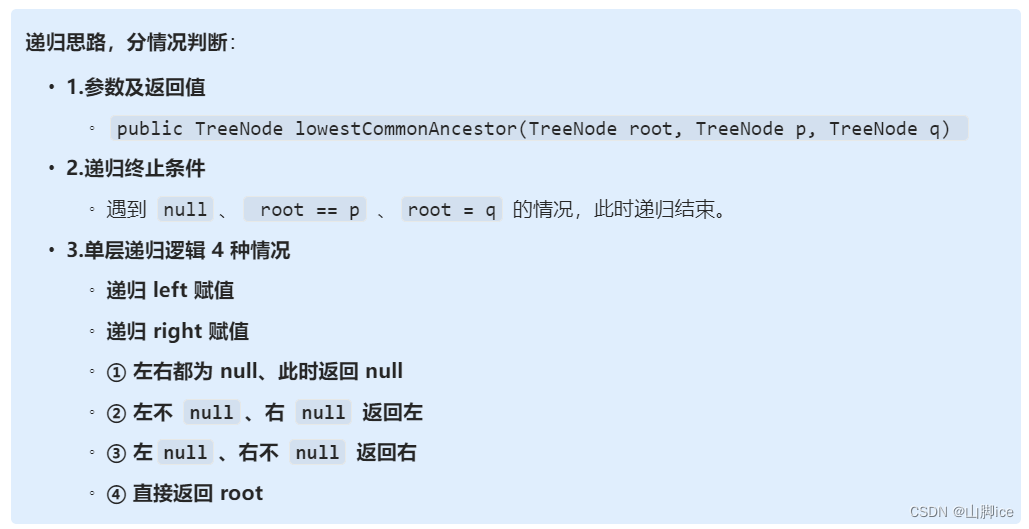目录
- 题目
- 1- 思路
- 2- 实现
- ⭐236. 二叉树的最近公共祖先——题解思路
- 3- ACM实现
题目
- 原题连接:236. 二叉树的最近公共祖先
1- 思路
模式识别
- 模式1:二叉树最近公共祖先 ——> 递归 + 判断
递归思路,分情况判断:
- 1.参数及返回值
public TreeNode lowestCommonAncestor(TreeNode root, TreeNode p, TreeNode q)
- 2.递归终止条件
- 遇到
null、root == p、root = q的情况,此时递归结束。
- 遇到
- 3.单层递归逻辑 4 种情况
- 递归 left 赋值
- 递归 right 赋值
- ① 左右都为 null、此时返回 null
- ② 左不
**null**、右**null**返回左 - ③ 左
**null**、右不**null**返回右 - ④ 直接返回 root
2- 实现
⭐236. 二叉树的最近公共祖先——题解思路

class Solution {public TreeNode lowestCommonAncestor(TreeNode root, TreeNode p, TreeNode q) {if(root==null || root==p || root==q){return root;}TreeNode left = lowestCommonAncestor(root.left,p,q);TreeNode right = lowestCommonAncestor(root.right,p,q);if(left==null && right==null){return null;}else if(left!=null && right==null){return left;}else if(left==null && right!=null){return right;}else{return root;}}
}
3- ACM实现
public class lowestCommonAncestor {static class TreeNode{int val;TreeNode left;TreeNode right;TreeNode(){}TreeNode(int x){val = x;}}public static TreeNode build(Integer[] nums){TreeNode root = new TreeNode(nums[0]);Queue<TreeNode> queue =new LinkedList<>();queue.offer(root);int index = 1;while(!queue.isEmpty() && index < nums.length){TreeNode node = queue.poll();if(nums[index]!=null && index<nums.length){node.left = new TreeNode(nums[index]);queue.offer(node.left);}index++;if(nums[index]!=null && index<nums.length){node.right = new TreeNode(nums[index]);queue.offer(node.right);}index++;}return root;}public static TreeNode findOne(TreeNode root,int val){if(root==null) return root;if(root.val == val) return root;TreeNode left = findOne(root.left,val);if(left!=null) return left;return findOne(root.right,val);}public static TreeNode lowestCommonAncestor(TreeNode root, TreeNode p, TreeNode q) {if(root==null || root==p || root==q){return root;}TreeNode left = lowestCommonAncestor(root.left,p,q);TreeNode right = lowestCommonAncestor(root.right,p,q);if(left==null && right==null){return null;}else if(left!=null && right==null){return left;}else if(left==null && right!=null){return right;}else{return root;}}public static void main(String[] args) {Scanner sc = new Scanner(System.in);System.out.println("输入二叉树构造数组");String input = sc.nextLine();input = input.replace("[","");input = input.replace("]","");String[] parts = input.split(",");Integer[] nums = new Integer[parts.length];for(int i = 0 ; i <parts.length;i++){if(!parts[i].equals("null")){nums[i] = Integer.parseInt(parts[i]);}else{nums[i] = null;}}TreeNode root = build(nums);System.out.println("输入val1");TreeNode p = findOne(root,sc.nextInt());System.out.println("输入val2");TreeNode q = findOne(root,sc.nextInt());TreeNode res = lowestCommonAncestor(root,p,q);System.out.println("公共父节点值为"+res.val);}
}








![[贪心算法]忍者道具](http://pic.xiahunao.cn/[贪心算法]忍者道具)






)


